Nanotechnology: sci-fi or sci-fact?
We’ve seen them in movies, but how close are we to having nanorobots in reality? And what will we do with them? We’ll be unpicking the tiny details of nanotechnology! Plus in the news this week: as Omicron cases continue to rise, what can we learn about it from South Africa? Researchers figure out why quitting smoking often leads to weight gain. And why we’re bad judges of when we’re over the drink-drive limit
In this episode

01:06 - Omicron: How dangerous is it?
Omicron: How dangerous is it?
Helen Rees, University of the Witwatersrand
It’s now almost 3 weeks since we learned of the emergence in southern Africa of the highly-transmissible Covid variant that the WHO christened “Omicron”. Helen Rees runs a medical research laboratory at the University of the Witwatersrand in Johannesburg. She also chairs South Africa’s medicines regulatory board - the equivalent of our MHRA - and is an advisor to the WHO for the southern African region. She told Chris Smith what they’re seeing so far…
Chris - For the moment, though, people who do succumb with don't know how serious the infection is going to be. But one way we can get some insights and try to find out is to look at the situation in South Africa where they're several weeks ahead of us, and now have had the chance to study the impact of the new variant on their populace.
Sally - Helen Rees runs a medical research laboratory at the University of the Witwatersrand in Johannesburg. She also chairs South Africa's medical regulatory body, the equivalent of our M HRA and is an advisor to the World Health Organisation for the Southern African region. She told Chris what they're seeing so far.
Helen - If we look at a month ago, South Africa's numbers of new COVID cases were really quite low. Between 100 & 200 a day with very few deaths. I think the population was feeling quite comfortable, but with Omicron, the numbers have really gone up extremely rapidly. It appears at the population level that this is a very transmissible variant. That means it spreads pretty easily. And we first saw it in groups of young people, but mostly mild and moderate disease.
Chris - When you say a big increase in numbers, you've gone from a few hundred cases per day. What sorts of numbers are we seeing now?
Helen - We've gone up to about 11,000 in a day, and it's going up. A particular concern was that this started in Parklands South Africa, which is the province with the highest population numbers. So many of the cases that we're seeing are in this province, but we are now seeing the numbers going up in other provinces as well.
Chris - I've visited Johannesburg many, many times. I've been on the roads and I've seen how people get to work. I've seen how people live in the environs of Gauteng. To what extent do you think your experience of the very rapid spread is a consequence of those factors versus actually it's the virus that is very, very transmissible?
Helen - Well, I think it's a combination of both. Undoubtedly, the conditions in which people live very close together very often particularly in the inner cities, in formal settlements and packed high rise and dense housing. That is one issue. But when numbers go down, people will become relaxed and they stop using all the public health and social measures that we keep talking about. Young people relax in particular. When we first saw these cases, it was in groups of young people. But I do think that the third issue here is undoubtedly to do with the virus being more transmissible. We saw this similarly with the Delta variants. So once we get these changes, we have to try and understand whether the changes we're seeing in the virus for a new variant actually do change the way it behaves. And it does seem to be more transmissible.
Chris - One crucial question must be who is catching this? Now you've said it first surfaced in younger people, but are these younger people who are vaccinated? Is it younger people who've previously been infected with coronavirus and recovered, and now they're getting this variant again? Is it unvaccinated individuals? Is it a mixture?
Helen - First of all, in terms of 'who is getting admitted to hospital?' It does seem that we've had a shift from older people to a younger age group, teenagers, but also children under five. Now that could be because our vaccination coverage is much higher in older people so it could be that what we're seeing is the protection of older people. But it's not completely that. The young people being admitted, the duration of stay in hospital is much shorter and in terms of disease severity, it seems to be less severe than we saw with the Delta variant. That's one piece of good news, but of course, with large numbers of people infected in the community we are seeing the numbers of admissions going up. Now your other question is, 'are these vaccinated, unvaccinated or people who've had infections?' There's two things there. One is that we are seeing people who've previously had an infection, a proven infection, that they are becoming reinfected. We're also seeing people who've been fully vaccinated, also becoming infected. However, in both cases, we're not seeing such severe disease. So although we're seeing vaccine breakthrough infections, we seem to be not seeing such severe disease.
Chris - Do you have a feel for what proportion of people are ending up having to come to hospital? Because that's of course the really big question when governments around the world are trying to safeguard their health service provision. They've got an eye on potential case burden and how many of those cases are likely to translate very quickly into cases that need hospitalization. So what fraction under these circumstances are ending needing hospital care, compared with Delta that we already have some familiarity with?
Helen - It's difficult for us to say what fraction because many people, especially with mild or moderate disease and many people will be asymptomatic, they're simply not testing. The people who are tending to test at the moment are people with more severe symptoms. So it's difficult to say how many people have got there, but what we are not seeing is the same steep rise of hospital admissions as we saw with Delta. Although the number of cases that we are detecting is going up very rapidly with Omnicon, we are not seeing the same sort of rise that we saw with Delta, which does suggest that the severity of the disease might be less so than we saw with Delta. We are obviously looking at this very closely, but at the moment, that's the impression that many clinicians have got. What we do know is the majority of people who are being hospitalized are the unvaccinated. So clearly vaccination is giving some degree of protection to those who are vaccinated.
Chris - Is South Africa currently growing the variant in the laboratory and doing the sorts of experiments that we really are aching for the answers to where we take antibodies that people have made in response to the vaccines that we've administered so far and asking the question, 'how many antibodies do I need in order to block the growth of this virus?' So we can work out whether the population is vaccinated or not really at the moment.
Helen - Yes, those studies are already well underway. In fact, we've already seen results of one of the studies. In that study, they looked at the new variant and they looked at how effective people who'd had the Pfizer vaccine were and how effective that vaccine was at neutralizing that virus. There was a really significant reduction in the effectiveness, but it wasn't a wipeout, it didn't get rid of the protective effect of the vaccine antibodies completely, which is encouraging because that means that we would anticipate that these highly effective vaccines would continue to have protection, even if that protection is somewhat reduced.
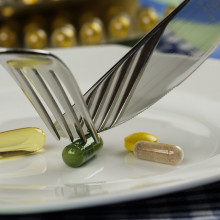
08:47 - Possible weight loss drug from smoking study
Possible weight loss drug from smoking study
Eran Elinav, Weizmann Institute of Science
Many people lose weight when they start smoking cigarettes; indeed, back in the 90s, many fashion icons seemed to exist on a diet of coffee and tobacco. Unfortunately, the reverse is also true - when people quit smoking, they very commonly put on weight: up to 10kg in a year, in fact. And this weight gain is one of the big reasons why many smokers are reluctant to give up. Now a team of microbiologists at Israel’s Weizmann Institute of Science have been using mice to try to figure out exactly what’s happening inside the body that causes this weight gain. And in doing so, they may have just invented a new weight-loss drug, as Sally Le Page heard from Elan Elinav...
Eran - We can control the amount of smoke that mice actively are exposed to, but once we stop their exposure to smoking, they put on a lot of weight within a very short period of time.
Sally - And is this just because they are hungrier so they're eating more food?
Eran - No. This was one of the first surprises that we encountered in this study. We found that they were gaining lots of weight but were not eating more or changing their exercise behaviours. Which was a very big mystery.
Sally -
But we all know that the way that people gain weight is because they either eat more or exercise less. So what's going on?
Eran - This was what we knew until 10 or 15 years ago, but we've since learned that there is a third mechanism and this is called 'energy harvest'. Which is the capacity of our body to extract different amounts of energy from a given type of food. Now we know that this energy harvest capacity is at least partially controlled by the activity of the microbes that reside within our gastrointestinal trial.
Sally - Okay. So you can eat exactly the same food, but one person absorbs more of the energy and the other person poops out more of the energy?
Eran - Exactly.
Sally - And you mentioned the microbiome, do mice also have a gut microbiome like humans do?
Eran - They do indeed. It is up to 90% similar to the one we observed in humans.
Sally - And how can bacteria and microbes in our gut change how much energy we get from our food?
Eran - There are many different ways by which our microbes can impact human health, but they can also secrete thousands of small molecules, which we call 'metabolites', into our bloodstream.
Sally - Coming back to this smoking and weight gain, are these bacteria producing chemicals that make us humans extract more energy from the food, or is it the gut bacteria themselves that are extracting more energy from the food?
Eran - That's an excellent question. The surprising result was that we found that these gut bacteria are actually changed and modified both in their composition and their behavior following the exposure of mice to cigarette smoke. What we've discovered was that two of these molecules, two of these chemicals that are secreted in an altered fashion by these gut microbes, can explain the dramatic tendency of mice to develop weight gain when they stop being exposed to smoke.
Sally - Why do these microbes want their host to absorb more energy from the food when they experience the chemicals from smoke?
Eran - When animals or humans are exposed to cigarette smoke. Because of the chemicals introduced through cigarette smoke, they tend to lose a lot of weight. The microbes, as our internal partners, try to reverse this tendency by increasing the secretion of molecules at our end and increasing the weight back.
Sally - Oh, bless. So our little gut microbes are trying to protect us from starvation when we are just trying to drop a dress size. I suppose the big question that a lot of smokers will be wondering is how long does this microbiome effect last after someone stops smoking? Because of course, weight gain isn't good for your health, but then neither is smoking. So if someone is to quit smoking, is that it? Have they doomed themselves to putting on more weight forever?
Eran - You know, we can only answer this question at this point in mice. Once you stop smoking, these bacteria are there to stay for many months. Whether this is the case in humans, we don't know. But the encouraging news, is that once we've discovered how the microbes induce weight gain and identified the two molecules that contribute to this tendency, we can now intervene during the smoking cessation period and either supplement mice or humans with the molecule that induces weight reduction, or block the activity of the molecule that induced weight gain. And by this, we can help people stop smoking without paying the price in terms of their weight gain.
Sally - So potentially you could get a pill that you swallow and it kind of knocks out the chemical causing this weight gain so that people won't have weight gain. I mean, that sounds amazing. Would that work with weight gain, not associated with quitting smoking?
Eran - We asked ourselves this exact question. Now that we've identified the bioactive molecules, we could give them to mice that are suffering from obesity, even in the non-smoking context. These mice are obese because of other reasons and they were never exposed to smoke. When we gave the weight reducing molecule to obese mice, they developed a quite dramatic weight reduction and improvement in metabolic parameters.
Sally - That is a massive discovery. I suppose it's like telling your gut microbes, "Don't worry, I'm not starving. I am just trying to lose a dress size. Don't worry about me. You don't need to keep me fat. We're not gonna die."
Eran - Exactly. And to quench our curiosity, we've even gone into humans and we tried to measure in smokers or in people that never smoke the same chemicals and the same microbes that we discovered in mice and to a large extent, the changes that we've observed in smoking humans were very similar to the ones that we've observed in mice. Which encourages us that maybe, and this will be followed up in clinical trials, some of the concepts that we discovered here in mice could be also applicable in humans.
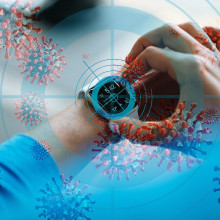
16:00 - Can a smartwatch detect coronavirus?
Can a smartwatch detect coronavirus?
Researchers at Stanford University’s Department of Genetics are harnessing the treasure trove of data that is being recorded 24/7 by smartwatches. Although wearable tech, including rings, wristbands and even sensors that can be incorporated into clothing, can do more than just measure heart rate and daily steps, it would appear that this simple data alone can provide powerful insight into the real-time health status of its wearer.
Mike - We're following your normal, healthy baseline. Then if there's a jump up in signal, an alert goes off and it works about 80% of the time. We'll get an alert at or before a symptom and it turns out it's an average of three days from our real time alerting system. So three days prior to people getting ill, on average a red alert will go off. Now we do miss it in 20% of the cases and we think that's because it's hard to get a stable, healthy baseline for some people. That makes finding these triggers a lot harder. That's why we're trying to improve our algorithms as well.
Tricia - And all of that is at the moment done from resting heart rate, but you want to look at heart rate variability, activity level and sleep quality. What are you hoping to find from that additional data?
Mike - We think that will be key to telling the difference between say a respiratory viral infection and a mental health stress, and other sorts of triggers. Things like alcohol and intense exercise can all trigger these alerts. Most of them you can contextualize and simply ignore. Certainly intense exercise, we should be able to ultimately subtract out because we'll see that from the smart watch.
Tricia - Yeah. Because with intense exercise, you're probably gonna have some kind of evidence of elevated heart rate from the intense exercise itself.
Mike - Exactly.
Tricia - What about asymptomatic cases? Were you able to detect those and how far in advance did you detect them?
Mike - Remarkably, we can find asymptomatic covid cases as well. 14 out of 18 asymptomatic cases we could pick up and in some cases, the signal appeared two weeks prior to when they were diagnosed.
Tricia - Because I'm a religious tracker of my own health, I already have access to my heart rate data and I tested positive asymptomatically and my heart rate spiked. Then it went down again at roughly the same time. But it's interesting that you say the alert comes about two weeks prior to that in some asymptomatic cases, because I had another infection about two weeks prior to that.
Mike - In our very first study, what we noticed is that about half the time people had another stress event prior to their COVID. We don't know what that was due to, it could have been another illness, it could have been possibly a mental stress, it's not clear. But we've noticed it was quite frequent, more than you would expect at random. What that means is that we think there may be early stressors that perhaps make people more susceptible to viral infections as well.
Tricia - You're preaching to the choir a little bit because I love my data and I wear a smartwatch. But if you were to try and convince someone who didn't really track their health and didn't wear an apple watch or anything like that, what would you say to them to convince them to start monitoring their health in real time?
Mike - I'd say, 'do you drive your car around without a dashboard?' Why do you drive your body around without a health dashboard? It makes no sense. I think that's what we need for human health. We currently rely on internal sensors, which kind of work, but they're slow. We think that these physiological sensors from smart devices can actually find things much, much earlier and warn people ahead of time before symptoms and that's super powerful.
Tricia - Every year, these smart watches seem to add another sensor. What do you think is the future for wearable technology and how much do you think we're gonna be able to gain from those wearable devices?
Mike - I think we're only at the beginning. For example, there's something called 'Galvanic Stress Response' that measures the conductance on your skin. That actually can tell you when you're getting stressed, because the more you sweat, the more it'll pick up a signal. Likewise, if you have diabetes, your skin gets drier and that can get picked up as well. So it's making certain kinds of measurements that we don't currently do and so we can actually incorporate that into health monitoring in a way that's never been done.
Tricia - So you're saying that nowadays my watch tells me to move if I haven't moved in an hour, but in the future, it's gonna tell me to drink and eat as well.
Mike - I think so. And it'll tell you when you're getting stressed, so maybe you better sit down and meditate.
Tricia - And it'll guide me through meditation as well.
Mike - Probably. Play music automatically. Maybe that's where we're going.

20:46 - A new state of matter! Quantum Spin Liquids
A new state of matter! Quantum Spin Liquids
Giulia Semeghini, Harvard University
There has been a huge find in the world of quantum physics. Real life laboratory based observation of a long theorised form of matter called Quantum Spin Liquid. Contrary to the name it has absolutely nothing to do with everyday liquids like water. Strap on your mental seat belt and settle in as Harry Lewis speaks to Guilia Semeghini from Harvard University to hear what this matter is and why it might be useful...
Guilia - Quantum spin liquids have been theorized about 50 years ago by Philip Anderson, who was a pretty big guy in the condensed matter community. He was trying to find a solution for why certain types of superconductors, which are called high temperature superconductors, exist
Harry - High temperature superconductors have long baffled physicists as they work at higher temperatures than normal superconductors still very cold mind you we're talking about -196 Celsius.
Guilia - So normally when you have a solid, you have the atoms are ordered in some crystal structure and the electrons are also somehow ordered.
Harry - And when you say crystalline, that means basically like a very uniform structure doesn't it? Something we can predict?
Guilia - They are in a certain structure. It can be a square lattice or a triangular lattice. You can think of something like that.
Harry - In most observed matter, electrons exist as either 'spin up' or 'spin down' and they like to pair up in opposites. Whenever you have a moving electron that generates a magnetic field, think of the ''up and 'down' a little bit like the north and south pole of a magnet. When electrons do pair up, they cancel out one another's magnetic fields.
Guilia - It's a magnetic equilibrium. Let's put it like this. If you instead have a triangular lattice for example, what happens is that the third one doesn't know which way to orient itself.
Harry - It's a third wheel.
Guilia - Yeah exactly. So this is what it's called 'frustration'. The third electron is frustrated and so his idea was that the electrons would choose to do something different.
Harry - It chooses to do everything, nothing, one thing and that other thing all at the same time. Get your head around that. It's a concept known as 'quantum superposition'.
Guilia - This is a quantum concept this idea of superposition. Where instead of choosing an orientation, they would create this state that is called the quantum spin liquid.
Harry - In regular magnets, when the temperature drops low enough, electrons stabilize and form solid matter with magnetic properties. Because the electrons are stuck in either a 'spin up' state or a 'spin down' state. In quantum spin liquid, the constant ambiguity of the electron state prevents freezing. It therefore has a range of unusual and novel properties such as, here's another one for you, long ranged quantum electron entanglement.
Guilia - Which simply means that basically the electrons that are on opposite side of the same piece of material, they're somehow tied in their state with each other.
Harry - That, my non physicist friends, is freaky. It's action at a distance. Altering the state of one electron on one side of the material would affect its partner all the way across on the other side of the material. Almost like when one twin in the UK gets hurt, and the other twin residing in Australia gets the shivers. After 50 years of searching Guilia and her team have observed for the first time, quantum spin liquid, sat there right in front of them on the lab bench.
Guilia - What you would see is this vacuum chamber, with a vacuum setup and a bunch of mirrors and lenses and lasers that occupy the quite big table, what you would see if you looked into the vacuum chamber with this microscope objective that we use, you would see these array of atoms. You really take photographs of the atoms and how they look like and they're actually very nice.
Harry - How did you identify this quantum spin liquid? What was it that proved that it was there for you?
Guilia - What you need to do is you need to prove that there is this entanglement that I was mentioning before. If they had specific properties, if you see these correlations, it means that you have a quantum spin liquid. We measured these and we found that they were there.
Harry - But why is there so much hype over this hard to wrap your head around quantum matter? What Guilia says is another step towards building the elusive quantum computer. If only I actually knew what that meant. We hear a lot about quantum computers. How do we define what quantum means?
Guilia - The basic idea of a quantum computer is this. When you have a computer you have bits, and the bits are the systems in which you encode the information. It's a system that can have a 'zero' or 'one' state. If you have a quantum computer, these bits are quantum, called 'quantum bits' or 'cubits'. The main thing is that being quantum means that they can exist in a superposition state, which is what I was mentioning before. A bit can only be 'zero' or 'one' while a quantum bit can be in a super position of these two states and anything in between. Which means it's not in 'zero' or 'one', it's in a superposition of these states. The second thing is that there is this entanglement property. If you have more cubits, they can be in these entangled states where their states are really connected to each other. You cannot treat them individually. You really need to consider their combined state.
Harry - And this could be really useful for future uses.
Guilia - The idea is that the quantum computers could do things that classical computers cannot do because, thanks to these qualities, you can basically multiply exponentially the calculation capability of this quantum computer.

27:21 - Do you know your alcohol consumption limits?
Do you know your alcohol consumption limits?
Kai Hensel, University of Cambridge
If you were nipping out to the pub for one drink, would you drive home? While we have guidelines for how much alcohol consumption is deemed safe before getting behind the wheel, ultimately, it's up to us to judge whether we’re over that - and our own - limit. According to research published this week though, we are not at all good at estimating how drunk we really are. Julia Ravey spoke to Kai Hensel from the University of Cambridge about these mis-measurements, and, without too much persuasion, volunteered to do her own self-assessment...
Kai - We had 90 participants that first had a standardized meal to ensure that everyone had the same caloric intake based on sex, age, body, mass index, and so on. Then everyone had the same amount of alcohol over time and we asked participants to come forward when they thought they were now on the edge of not being allowed to drive a car anymore. 40 to 50% based on the study day were actually already exceeding that limit. They then kept drinking for about double of the amount of the echo concentration that you would be allowed to have in your blood to still drive a car. The more the intake was the poorer, the judgment, so the less accurate the self-estimation was.
Julia - Wow. So essentially the more drunk people got the less good they were estimating if they'd reach that limit.
Kai - Exactly.
Julia - I am treating myself to a nice little glass of wine. It's really cold outside and, you know what? I deserve a treat. But I'm gonna see if I can judge when I have reached the legal limit for driving, which in the UK is 0.08%. I've bought myself a little breathalyzer and what I'm gonna do is eat my dinner. I think for me, being five foot five, I could have a medium to large glass of rosé and I think I'd be fine to drive. But I'll take the breathalyzer and see if that is the case. How good am I at estimating my alcohol limits? Cheers to a good week. [drinks alcohol] I've just finished my dinner and my glass of wine. Before I take my breathalyzer, I have to be nil-by-mouth for 15 minutes. Just to clarify, I'm in my house and I'm not leaving for the night, but I feel fine and I think I would be okay to drive a car. While I wait to take my breathalyzer, I thought I'd ask if there is any way that we can improve how perceptive we are about how much alcohol we've had.
Kai - In this study. We asked everyone to come back a week after they participated first in the study, and then we did the same again. We again, looked at how well they could estimate whether or not they were still under the drink-driving limit to drive a car. Interestingly, they became more accurate on the second time. While we didn't tell them the first time how drunk they were, just by participating in the study, they were already improving their self estimates.
Julia - After performing this study, what is the take-home message for people thinking about driving home after having a drink?
Kai - The take-home message is not really surprising. Obviously it's unsafe to drive while you're under the influence of alcohol. The importance is that more people than would you think are actually misjudging how drunk they are already. There's actually quite good estimations you will find apps or websites where you can just put in 'I'm 26. My body weight is six kilograms and I'm female. I had two beers over three hours. What's my estimated blood alcohol level?' You could use those as a guess and they are not too bad on average. This works quite well.
Julia - It's been 15 minutes now and I'm ready to take my breathalyzer. I dunno how much I should trust this because I bought it off the internet and it says it is intended to control overdrinking of alcohol. Well, it's true in a way, isn't it? We don't want to overdrink alcohol. [breathalyzer beep] 0.34? No, that can't be right. That means I'm almost five times over the limit. I'm gonna do that again. [breathalyzer beep] Percentage is 0.06. I think that's more like it. Okay. As a good scientist, let's do one more test. [breathalyzer beep] 0.06. So I am technically under the legal limit right now to drive in the UK. But in other countries like Germany, the limit is 0.05 so with that one glass of wine, I'd actually be over the limit. That first reader really scared me. I can't believe it said 0.34%. I would've drank about three bottles of wine to be at that level. That's the importance of repeating things at least three times. As I'm actually not driving anywhere right now and I'm in my flat for the evening, maybe I should repeat the drink test as well. Cheers.

33:57 - Nanotechnology at home
Nanotechnology at home
Lauren McHugh, University of Cambridge
Katie King went around her home before work with the help of material scientist, Lauren McHugh from the University of Cambridge, to show that nanotech is very commonplace and answer Sally Le Page's questions...
Sally - What is nanotechnology other than yet another buzzword?
Katie - Oh, but it is my favorite buzzword. Well, for starters, 'nano' means very, very small.
Sally - Okay. But how small is small?
Katie - Well, much smaller than those iPod nanos that you might remember. What we're talking about is a millionth of a millimeter. Stuff on the near atomic scale. Nanotechnology is about controlling and building materials on this length scale for a whole load of different purposes.
Sally - Why do you need to control it on such a small scale? Surely if it's so small, it won't make much of a difference.
Katie - That is a good question. As an example, let's take diamond and graphite. Both of them are made up of only carbon yet they have very properties. I can't imagine you'd be best pleased with a ring, with a chunk of graphite on it.
Sally - I dunno. I mean, I'd never be lost for a pencil.
Katie - That's true. These differences are down to their nanostructures and their differences in their nanostructures. By controlling things on the nanoscale, we can end up with some very different and very interesting properties.
Sally -
But when exactly am I gonna need a nano material? This all sounds like stuff from a science fiction novel and not something particularly useful in my everyday life. We've all got bigger problems to worry about right now.
Katie - I thought you would need some convincing so earlier this week I went around my home before work to show you that nanotech is very commonplace.
Katie - Right time to get up. It's a beautiful chilly day outside. First thing's first time to take my lateral flow test. They always made me want to sneeze. We are all more than familiar with lateral flow tests, but did you know that the red lines are in fact made up of gold nanoparticles? We all know gold is shiny and yellow, but when we cut it up into tiny nanoscale chunks, it takes on new properties and appears red. Nanoparticles of materials can have very different properties compared to the material at larger scales, which is one of the things that makes them so useful. While I wait for my test results, time to shove a wash on. You may not know this, but powdered washing detergent contains a nanomaterial that makes our detergents more efficient. Lauren McHugh, from the University of Cambridge is going to tell us a little bit more.
Lauren - If you look on the back of a box of soap powder, you'll probably see zeolite as an ingredient. Zeolites are crystalline materials and they're composed of aluminium, oxygen and silicon. They contain microscopic channels, which we refer to as 'pores'. The cage light structures of these zeolites make them really useful in water softening. In water softeners hard water, such as that we have in Cambridge, contains calcium and magnesium ions, and it's passed through sodium containing zeolites. The calcium and magnesium ions in the water are trapped by the zeolite and the sodium ions present in the channels of the zeolites are released. The new water contains sodium ions, and this can be considered 'soft'. When washing and hard water, magnesium and calcium precipitate with soap, which hinders the formation of subs. However, when the ion exchange occurs, the sodium ions now present in the water do not precipitate with the silk and this leads to the formation of more suds and a more efficient detergent.
Katie - I guess that's one way of saying we are slightly less bubbly here in Cambridgeshire. All of that hard water and minerals in the water can mean that tap water can leave that off-putting taste for some people. Bet you didn't know that another place where nanotechnology is used is in water purification filters. Lauren, what's going on inside these filters?
Lauren - Water filter will contain activated charcoal. This is another highly porous material similar to zeolites. Activated charcoal has an extremely high surface area, and it's really effective in absorbing contaminants. The chemicals that activate charcoal tends to remove would be things like chlorine or anything that has an odour and then these water filters will also contain ion exchange resins. These will help to again, remove some of the hardness from water.
Katie - While that filters, I better go brush my teeth. My toothpaste also contains activated charcoal. What's that meant to do for my teeth?
Lauren - In cosmetics a lot of the time activated charcoal will be used to detoxify. If you go into any pharmacy, I'm sure you'll see an abundance of face masks that say 'these activated charcoal face masks will detoxify your skin and remove impurities.' Similarly, if you then take an activated charcoal toothpaste it will claim to remove stains from your teeth. You're going to be binding impurities to surface the carbon.
Katie - Do you think it works?
Lauren - I do have my reservations about it. Activated charcoals are actually very granular. I think a lot of the time you're probably just rubbing a part of the surface if your teeth off by using these toothpastes. So it's up to you, they may do something about removing stains from your teeth, but you're also probably rubbing part of your teeth off in the process. So very much up to you whether you use them or not.
Katie - Right now that I've, nanoteched my teeth, my COVID test has come back as negative. I'm running late. I need to get out the door and get on my bike with a frame that's reinforced with, you'll never guess it, carbon nanotubes. So you see Sally nanotech really is everywhere.

39:59 - The secret to the Sword of Damascus
The secret to the Sword of Damascus
Michael De Volder, University of Cambridge & Magnus Sigurdsson
Carbon nanotubes are rolled up tubes of graphene, which you may have heard of. These are far stronger than steel yet far lighter than steel making them a very interesting material. Although carbon nanotubes sound like a new fad, they actually date back to a very long time ago. Legend tells of a sword with mystical properties. Blacksmith Magnus Sigurdson tells us the story of the sword of Damascus, with Michael de Volder, materials engineer from the University of Cambridge, on hand to explain to Sally Le Page and Katie King the science behind the myth...
Magnus - There are many stories from the third crusades of King Richard meeting Saladin. They decide to compare sword blades. King Richard the Lionheart produces his sword of Frankish steel and cuts through an inch thick iron bar, having no damage to his blade whatsoever. Saladin then produces his lighter blade, which shines with a blue gray effect. Looking closely at the blade, it looks like a starry night being viewed over a rippling pond. With this he lays out a silken scarf and cuts through it with one swipe. King Richard swears he has never seen such a blade so sharp.
Sally - Okay. Not gonna lie. That was a great story. But what does any of that have to do with carbon nanotubes?
Katie - There is a lot of speculation, but a few years ago, this mythical mystical magical material, Damascus steel was discovered to contain these carbon nanotubes and they reckon that it might be these nanotubes is what made the sword so strong.
Sally - So you're telling me that you've been bigging up nanotechnology at the start of the show as something new and "cutting edge" when actually we've been using it for a thousand years.
Katie - It's true that these structures have existed for a while, but it's only recently that we've been able to control how we make these structures and therefore control their properties.
Sally - Someone who knows all about that is Michael de Volder, materials engineer from the University of Cambridge, who specializes in carbon nanotubes. Michael, what makes Damascus steel and therefore Saladin sword so strong?
Michael - I'm not sure anyone really knows but as you mentioned what people have discovered in 2006, is by actually dissolving a little bit of the Damascus sword in acid, is that there is carbon tubes inside. Now that brings about two mysteries. How did the carbon tubes get in there in the first place? And what do they do to the steel to make it better?
Sally - Well exactly. I think carbon nanotubes are something modern and fancy you need a lab for. How did the nanotubes get in there that many years ago?
Michael - For that we need to understand how carbon nanotubes are made. Although they sound very fancy, actually their synthesis is very much like gardening; something you've all done. For gardening you need some seeds, you need some energy from the sun and you need soil and fertilizer to make the plants grow. In the case of carbon nanotubes, those seeds are little metal clusters, often times iron. The food you feed them instead of soil would be hydrocarbon. Then you need some energy from heat. If you think about how a sword is made, there's lots of iron in the steel which connects as a seed. You heat them up to high temperature, which is also what's needed for carbon nanotubes. Then the question is where would the carbon source come from to make the nanotubes, and turns out that in the recipe of the Damascus sword, people did add various leaves and wood to the steel as they were making it and that could very much have been the carbon source or one of the carbon sources to make the nanotubes.
Sally - So they knew that they knew that they were adding these leaves and they ended up with stronger steel, but obviously they wouldn't have known that they were building these carbon nanotubes, but they did it anyway.
Michael - Exactly. A lot of times discoveries are made by serendipity and people do things without necessarily knowing how exactly they are made.
Sally - What gives carbon nanotubes their strength? Why does having them in your steel make your sword so strong?
Michael - The bond between the carbon atoms in a material like graphine, which is essentially the same as the surface of a carbon nanotube, is a very special bond that is mechanically very strong. It also allows the carbon atoms to share electrons and makes material electrically conductive. It's a very, very special bond that we have in between the carbon atoms in carbon nanotubes.
Sally - How long are these tubes? I mean, we call them nanotubes, so obviously they're small in diameter, but how long can they get?
Michael - That's a very interesting question. The pieces that were found in the Damascus sword, which I've seen images of, were fairly short, but the current world record in the length of a single nanotube is about half a meter long.
Sally - That's not nano, but it's only a few atoms across and half a meter long?
Michael - That's correct. The diameter is tiny. The ratio between the diameter of planet earth and the tennis ball, is about the same as the tennis ball and that nanotube. Although it's very long, it's diameter is still at a nano scale.
Sally - Are we still using nanotubes? Are they still useful or are they just a marketing fad?
Michael - When carbon nano tubes were discovered and were looking for an application, they were often advertised for sporting goods and so on as a marketing tool. But then people start finding it quite easy to use them as additives in for instance, polymers and then making those electrically conductive. That turned out to be a big commercial success in automotive applications and a couple of other applications as well. Making a plastic conductive tends to be very interesting if you want to paint cars or use certain plastics in fuel tanks where by law, the material needs to be conductive.
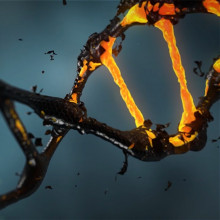
45:49 - Nanomachines made from DNA
Nanomachines made from DNA
Kevin Lim, University of Cambridge
Katie King had a chat with Kevin Lim, nanoroboticist at the University of Cambridge, to find out what nanorobotics is...
Kevin - It's to make gray goo like tiny nanorobots that will self replicate and take over the world and destroy everything. Just kidding. Even if we want it, we are pretty far off from that stage.
Katie - If nanorobots aren't there to take over the world, what are they?
Kevin - So normally you have nanoparticles, which are just very small blobs of stuff, essentially, which we look at and play with at the nano scale. But if you can go a step further and actually make them do something, have some sort of a controllable function that is useful, then you could call that a nanomachine or a nanobot.
Katie - What sort of functions are these nanorobots performing?
Kevin - It depends on the application. In my project, one of the goals that we had at the start was to make a machine that could basically take two other particles and stick them together. It'd be basically like a nano-stapler,
Katie - You said you made these nano staplers out of DNA. How does that work?
Kevin - The really cool thing about using DNA is that you can essentially program it to assemble in a certain way by controlling the sequence of DNA basis. If you're familiar with this idea of the A&T and G&C basis in DNA, you've got these four and they pair up in a certain way. A pairs with T and G pairs with C. This forms, this classic double helix structure, but you can go further and you can make sort of super structures of this. So you can have double helices that are running in certain ways that form a bigger shape. It's a little bit like knitting or crutching.
Katie - You've used DNA to knit together your structure, but how is that a nanomachine?
Kevin - You could have a nano-stapler that just flops around and does whatever it wants, but that wouldn't really be a machine in the sense that you couldn't know when it was going to do its job and you couldn't tell it to do it. You couldn't tell it to start and to stop. That's what I would call a 'nanomechanism'. It has the ability to transmit force and to do these things, but not so much in a controlled way.
Katie - What would you say is the difference between a nanomechanism and a nanomachine?
Kevin - The difference between a mechanism and a machine is a little bit like the difference, a trained dog and an untrained dog. The untrained dog does certain things, but you don't really have the ability to tell it what to do and to know when it's gonna do them. Whereas a trained dog actually does certain tricks that you've taught it and you can reliably expect them to do those tricks at the right times.
Katie - And what do we use to control or are we trying to use to control these nano machines?
Kevin - The control signals that we have, one of them could be the pH. You could program it so that when the pH becomes acidic or alkaline to a certain point, that it would release its payload and release the drug to the target. Another way is that you could use light. With certain types of nanoparticles, with certain types of nanomaterials, they would be light responsive. By illuminating them or shining light on them at a certain point, you could get them to do their thing.
Katie - You can use different things as your stimulus, as your trigger. As nanorobotics is working to train these nanoparticle dogs, if you will, to perform on command, where do you see this leading in the future?
Kevin - If you look far into the future, it's not impossible that you could have some sort of a very rudimentary neurosurgeon. Even if we have these nanorobots of the future, they aren't going to look anything like sci-fi and they're not gonna look basically like tiny, shiny terminators or anything. They're probably gonna look like more or less blobs that flop around, but somehow get a job done. If you just wanted something that's going to bring a certain drug to a location in the body and release it on command. That's not so far off. I mean, that's being done.
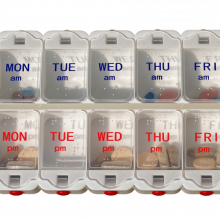
51:48 - Nanotechnology vs diseases
Nanotechnology vs diseases
Silvia Sonzini, AstraZeneca
Silvia Sonzini is a drug delivery scientist at AstraZeneca who has been working on creating different ways of using nanotechnology to deliver medicines for different diseases. She explained to Sally Le Page where we're at with using nanotech inside the body...
Sally - Silvia, we've just been hearing about nanorobots. So are you also building, tiny, shiny little robots that float around in your blood delivering medicines?
Silvia - No. Well, we are really not working on that. Nanomedicines are quite far from being a robot like material, but nanomedicine are drug delivery systems. You can imagine them as a polymeric or oily particles that are carrying around active molecules in our body, and really allowing them to reach the tissue of interest and even into the disease cells.
Sally - So you say that they're tiny particles, how big are these things compared with our human cells?
Silvia - They're very, very tiny. They're about 100x smaller than a cell, and there are many different size of nanomedicine. It's difficult to say specifically one size, but really they're so small compared to that many can be eaten by each cell at once.
Sally - Presumably they must be quite tricky to make and quite expensive. Why would you want to use nanomedicine rather than just injecting the drug into someone's bloodstream? Like we've been doing for hundreds of years.
Silvia - I can't really discuss too much about why they're expensive or not, but really nanomedicine are at the forefront of medicine. They allow us to bring specific molecules to a specific part of our bodies and really reach some target that wouldn't be able to be reached in other ways with the standard drug molecules.
Sally - How can they recognize one cell over another? Katie was just talking about them, targeting cancer cells. How can something so small recognize a difference between a cancerous cell and a healthy cell?
Silvia - We are using an active targeting system, which means we are adding a biological part on top of our nanomedicine that can interact with a lock and key mechanism with the disease cells. So it can really discern between disease and healthy cells.
Sally - Is this all just science fiction or is any of it being used already?
Silvia - No, actually there are some nanomedicine already on the market and many are in the clinic. We have two in the clinic right now, and many more than are going through preclinical and clinical studies at the moment.
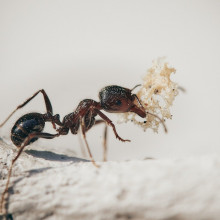
54:19 - QotW - Why are ant bites so painful?
QotW - Why are ant bites so painful?
Sally Le Page got the painful truth from insect venom expert Sam Robinson, from the University of Queensland...
Sam - Firstly, while most ants do bite, their bites are almost always inconsequential to us, it is their stings that typically grab our attention. There are ~20,000 species of ants worldwide and, like their wasp ancestor most can sting (technically, ants are just a family of wingless wasps).
Sally - Bite or sting, it still hurts. Why does it have to hurt so much?
Sam - Yes, the stings of many species can be very painful. Why? Because they have to be to survive. Ants are eusocial, that is they live in colonies. Their colonies include their young (eggs, larvae, pupae), which collectively represent a stationary and helpless nutritional bounty for a large predator e.g. reptiles, birds, mammals. Ants need to be able to defend their colony against predators in order to survive and a painful sting is a very effective strategy to achieve this.
Sally - It certainly got this large ‘predator’ away from the ant colony veerrrrry effectively. I wonder, what is in the ant venom that makes them so painful even with such a tiny sting?
Sam - Not all ant stings are equal, some are more painful than others. This reflects the different doses of venom they can deliver in their sting, and also their different venom chemistries. Some of the more painful ant stings are caused by venom molecules that (very effectively) target and over-activate a key part of our sensory nervous system, voltage-gated sodium channels, which are important for amplifying and transducing normal pain signals. Other ants use chemicals that cause pain in other ways—a variety of different chemical strategies probably exist.
Sally - There we go! And you can curse your overly activated voltage gated sodium channels next time you’ve got ants in your pants. Next week’s toes-ty question comes from Patrick:
Patrick - When I have cold feet, why won’t my brain let me sleep?
Related Content
- Previous Flowers in Space
- Next Can Corals Resist Bleaching?










Comments
Add a comment